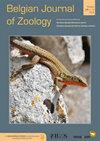Local distribution patterns of harvestmen (Arachnida: Opiliones) in a Northern temperate Biosphere Reserve landscape: influence of orientation and soil richness
IF 1.1
4区 生物学
Q2 ZOOLOGY
引用次数: 8
Abstract
The study at a local scale of the fauna in a natural mountain landscape provides insights regarding the patterns and the factors influencing distribution. We test if each type of natural forest and some open habitats in the Muniellos Biosphere Reserve have their own unique harvestmen assemblages. We further investigate the presence of groups of sites sharing harvestmen assemblages and the factors and indicator species involved. Nineteen sites with well-known phytosociological association were sampled during nine surveys from late 2001 to 2002 by means of three sampling protocols. The quality of the inventories was assessed via the corresponding species accumulation curves. The cluster analysis using the Bray Curtis similarity index showed the presence of two main distinct groups of sites. One group consisted of seven lower forest sites, while the second group contained samples from more open sites and lighter forests. IndVal analyses show the first group has six characteristic species and the second group has one. ANOSIM analyses revealed that the harvestmen community composition was significantly different between the two clusters. Orientation appears to be one main driver of harvestmen assemblages on Mount Muniellos: a clear distinction between the two clusters appears along the boundary of shady to sunny habitats. The vegetal associations that house the higher harvestmen species richness have the higher soil richness. Seven rare and infrequent species were found in forests with richer soil.北温带生物圈保护区景观中收割机(蛛形目:Opiliones)的局部分布模式:方向和土壤丰富度的影响
对自然山地景观中动物群的局部尺度研究提供了有关其分布模式和影响因素的见解。我们测试了穆尼埃洛斯生物圈保护区的每种类型的天然林和一些开放栖息地是否有自己独特的收割机组合。我们进一步调查了共享收割机组合的站点群的存在以及所涉及的因素和指示物种。在2001年底至2002年的9次调查中,采用3种取样方案对19个具有植物社会学关联的地点进行了取样。通过相应的物种积累曲线来评价库存的质量。利用Bray Curtis相似指数进行聚类分析,发现存在两个主要的不同类群。一组包括七个较低的森林地点,而第二组包含来自更开放的地点和较轻的森林的样本。IndVal分析显示,第一组有6个特征物种,第二组只有1个。ananosim分析显示,两个群落的群落组成差异显著。朝向似乎是穆尼埃洛斯山上的一个主要驱动因素:两个星团之间的明显区别出现在阴凉和阳光栖息地的边界上。收获植物物种丰富度高的植被群落土壤丰富度也高。在土壤较肥沃的森林中发现了7种罕见的物种。
本文章由计算机程序翻译,如有差异,请以英文原文为准。
求助全文
约1分钟内获得全文
求助全文
来源期刊

Belgian Journal of Zoology
生物-动物学
CiteScore
1.90
自引率
0.00%
发文量
10
审稿时长
>12 weeks
期刊介绍:
The Belgian Journal of Zoology is an open access journal publishing high-quality research papers in English that are original, of broad interest and hypothesis-driven. Manuscripts on all aspects of zoology are considered, including anatomy, behaviour, developmental biology, ecology, evolution, genetics, genomics and physiology. Manuscripts on veterinary topics are outside of the journal’s scope. The Belgian Journal of Zoology also welcomes reviews, especially from complex or poorly understood research fields in zoology. The Belgian Journal of Zoology does no longer publish purely taxonomic papers. Surveys and reports on novel or invasive animal species for Belgium are considered only if sufficient new biological or biogeographic information is included.
 求助内容:
求助内容: 应助结果提醒方式:
应助结果提醒方式:


